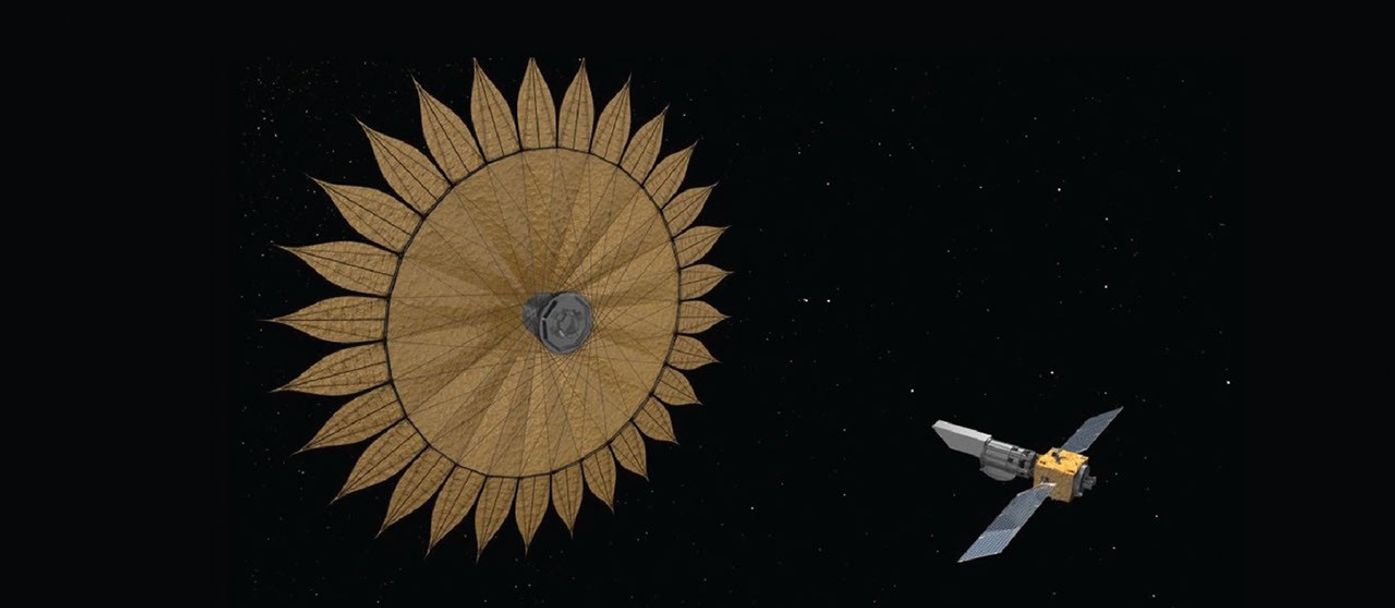Starshade Technology Development
The Exoplanet Exploration Program Charter identifies one of the Program’s critical functions to be to “…manage exoplanet-related technology initiatives, including the management of specifically directed technology activities, facilitation of a coordinated NASA Astrophysics technology identification/prioritization process, oversight of competitively-selected technology activities, and certification of technology milestones and or Technology Readiness Levels (TRLs).”1
A key method in the pursuit of these goals and objectives is the direct imaging of planets around other stars. Directly sampling the light from an exoplanet separately from that of its host star facilitates measurement of its size, orbit, albedo, and ground and atmospheric spectra, which provide clues to its habitability, and potentially could provide signatures of the presence of life itself. However, direct observation of small, rocky planets like Earth close enough to their host stars to harbor liquid water is very difficult due to the extreme faintness of the exoplanet relative to the very nearby star. The starlight must be suppressed, either interferometrically or by an occulter, to allow exoplanet detection. Occulters that are internal to the telescope are referred to as coronagraphs. Occulters that are external to the telescope are referred to as starshades.
Starshades benefit NASA by enabling and enhancing NASA’s capability to detect planets around other stars, characterize them, and search them for signs of life. They do this by dramatically extending the ‘field of regard’ of direct imaging studies towards small, rocky planets orbiting in the habitable zones of their host stars, the regions where liquid water can be sustained on the planets’ surfaces, and towards characterization of the surfaces and atmospheres of those planets.
In 2016, NASA’s Astrophysics Division Director approved a proposal by the ExEP to restructure its starshade-related technology development investments into a focused activity to bring starshade technology to Technical Readiness Level 5 (TRL5).2 This focused activity is called S5. In September 2018, NASA’s Astrophysics Division approved the plan to proceed with the implementation of S5 to address the three most critical technologies for Starshades. These technologies are: starlight suppression, formation sensing and control, and deployment accuracy and shape stability.
1Exoplanet Exploration Program Charter, section 4.4
2Memo by Paul Hertz dated March 23, 2016.
Videos
10m Starshade Inner Disk Deployment
Starshade Rendezvous Mission Concept Animation
Starshade Wrapped Architecture Deployment Concept
5m Inner Disk Development Model Deployment
PLUS Visualization & Hardware Deployment Overlay
Starshade Deployment Animation
More Resources
Starshade Technology Development Activity (S5) Documents
- Milestone #1
- Milestone #2
- Milestone #3
- Milestone #4
- Milestone #5
- Milestone #6
- Milestone #7
- 7A Report - Demonstration of Dimensional Stability of Perimeter Truss Bay Longeron and Node
- 7B Report - Demonstration of Dimensional Stability of Truss Bay
- 7C Report - Demonstration of Deployment Accuracy of the Starshade Inner Disk Subsystem
- 7D Report - Demonstration of Deployment Accuracy of the Starshade Inner Disk Subsystem
- Milestone #8
External Links
- Starshade Imaging Simulation Toolkit for Exoplanet Reconnaissance (SISTER)
- Starshade Rendezvous Mission (SRM) – Probe Study Report
- Habitable Exoplanet Observatory (HabEx)
Starshade Science and Industry Partnership (SIP)
SIP Documents
- Terms of Reference (5/30/2019)
- Starshade Exoplanet Data Challenge Request for Proposal (Closed)
- Solicitation of Nominations for the Technology and Science Working Group (TSWG)
- SIP TSWG Members
- Small Business Awards Notice
SIP Mailing List
To subscribe, send an email message to the address below with the subject “subscribe starshadesip” and your Firstname and Lastname, leaving the body blank. Please note, you will need to reply to email from JPL to confirm your membership.






























